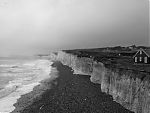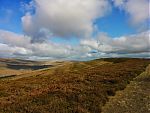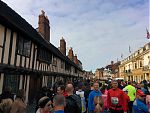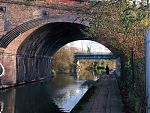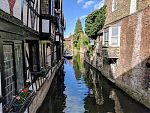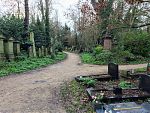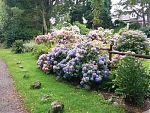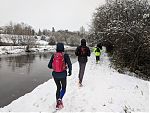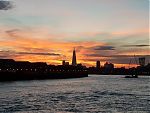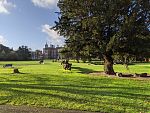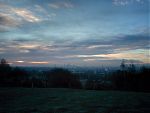1. Januar 2020
London ─ Path to the outdoors
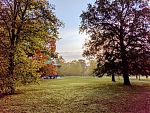 How to find the outdoors while living in London • London has surprisingly many green spaces • thanks to Paul New, Cliff King, Rachel Dench • thanks to the London Social Runners • on England’s history of volunteering • you cannot avoid the air pollution • you often have to stay on public footpaths • historic sightseeing in run-by mode.
How to find the outdoors while living in London • London has surprisingly many green spaces • thanks to Paul New, Cliff King, Rachel Dench • thanks to the London Social Runners • on England’s history of volunteering • you cannot avoid the air pollution • you often have to stay on public footpaths • historic sightseeing in run-by mode.
In my previous post, I had mentioned how I had been overwhelmed by the vast expanse of urban London. Today, I am going to write how I adapted; mostly through running in London and around London, as well as day hikes.
I’m much indebted to Paul New who’s organising day hikes under his aptly named Love to Hike brand, and much owing to the London Social Runners. Both groups had a considerable impact on my life in London and helped me explore the green spaces in London and around London. Finally, I also owe Cliff King and Rachel Dench for showing me around the countryside while coaching me for ultra running, a hobby I picked up while in London (see Wendover Woods 50: First Ultramarathon).
When I arrived in London, I soon felt the urge to get out and see nature. On hindsight, I can say that I took a two-pronged approach: exploring London’s numerous parks (see e.g. my attempt to bag as many parks as I could in a single day: Runsightseeing: Thirteen London parks in a day), and going on day trips outside London.
Within two weeks of my arrival In London, I hopped on a train and explore the coastline. I went to Eastbourne from Clapham Junction, because it allowed me to take a look at the famous Channel. I’ve written about this before (Eastbourne via Beachy Head towards Seven Sisters), but I’m mentioning it because this trip inspired me to go and explore more of London’s surroundings.
Another trip that inspired me brought me to Royal Tunbridge Wells. This was a random place I went to after discovering a green spot around it on Google Maps. I didn’t know at the time what a public footpath was (and promptly ended up in someone’s backyard), and was surprised that almost all of the countryside was fenced off. Very orderly but also strange after the vast open, accessible nature in Sweden where you can just veer off the path and walk through the forest. This isn’t possible in the lush English countryside. Land is private and off limits. And there are almost no forests either. This didn’t deter me though.
As I was still suffering from a small injury whose origin I cannot remember anymore, I started off with mostly going on organised hikes by Paul New. Paul organises day hikes pretty much every Saturday, regardless of the weather, regardless of the turnout, regardless of the mud. They are demanding hikes, and they took me to many corners; foremost in the southwest of London, and always to some country pub at the end. Paul knows many nice places to explore by foot, and I’m grateful.
My most memorable hike with Paul was probably the Isle of Wight. One of my colleagues at work once came in to the office, limping a bit and explaining he had just run around the Isle of Wight in a day on the weekend. So I thought, this would be doable in three days and suggested it to Paul who turned the vague idea with astonishing precision into a fantastic hike around the island. Yet, this hike around the Isle of Wight also pushed me to the limits. Both in how far I can walk and how much pub food I can stomach in subsequent days. When I ordered salad, all I got was chicken with a little bit of green leaves for decoration!
From a historical point of view, this was the first time in the UK where I saw how the seaside resorts built in the 19th century look nowadays. I’m quoting Eric Hobsbawm here:
The middle class, however, travelled more seriously. The most important form of such journeys, in quantitative terms, was probably that to the family summer holiday or (for the more affluent and overfed) to the annual cure at some spa. The third quarter of the nineteenth century saw a remarkable development of such resorts ─ at the seaside in Britain, in the mountains on the continent.1
The hike around the Isle of Wight provided not the only surprise about pub food (good and bad). I remember a pub in Wales that─without requesting it explicitly─served chips along with the lasagne. This also happened on a trip with Paul, this time to take part in a day hike organised by a charity, the Longtown Mountain Rescue Team (see my previous post on 50 km of Wales in a Day: Big Black Mountains Challenge 2015).
The Longtown Mountain Rescue Team is an example for England’s long tradition in charities, run by volunteers and funded through public donations. Another example worth mentioning here is London’s Air Ambulance. Or the Canal River Trust, which I supported in the past because they are taking care of the canal towpaths that offered so much to me when run-commuting to work. Historian Robert Tombs writes:
Charities, extensive in the eigeenth century, greatly expanded [during Victorian times]: Charles Dickens described Victorian charity as ‘unexampled in the history of the earth’ […]2
A History of Britain ─ Volume 3: The Fate of Empire 1776-2000 by Simon Schama3 provides more depth on Victorians and philanthropy, which is a very complex topic which I cannot give justice in this post.
So much about exploring the outdoors through hiking. Let me segway to the other way on how I got to see more nature: by running through parks and open spaces in London. London is a surprisingly green city, although that doesn’t mean that most of London is publicly accessible green space.
One of my favourite parks in my early days was Richmond Park, which offers nice trails, deers, and even a view over London. Clapham Common and Wandsworth Common out of convenience for a quick dash around the block. I discovered the London Social Runners, and on Saturdays I would often run from Clapham Junction to Kensington Gardens, where we’d do a loop around Hyde Park and Kensington Gardens before socializing for some (in my case, second) breakfast.
I enjoyed the company from the London Social Runners. I soon joined their longer runs that happen on a monthly basis. They showed me around, and it was great to meet people. One thing leads to the other, and I joined the group of volunteers organising the runs. It feels great to give back, and soon I found myself in the position to show others on where to find the outdoors─in London (e.g. Parkland Way) and around London (e.g. North Downs Way).
So what’s great about organising runs for a group? It’s the same as cooking for friends. Cooking for yourself is just not as rewarding: it takes time to select a recipe. It takes time to do the shopping. It takes time to prepare the meal. And then you just eat it yourself? Much better if there is at least one person to share the meal with─moreover, having someone to share a meal with is an incentive itself to put more effort into the cooking. What does cooking have to do with running? Well, when I prepared long runs for a group, I would put more effort into researching worthwhile running routes than if I just went out running by myself. And it’s sometimes more fun running with a group, particularly if you’re new in town.
A colleague at work inspired me to get into ultra-running, i.e. the business of running so far that everybody thinks you are insane. I decided to get myself some coaching and not jump into this new hobby without some guidance. So a big thanks here to Cliff King and Rachel Dench who showed me what I can actually do if I put my mind to it. The great thing about ultra-running in the context of this article─finding the outdoors when living in London─is that both training and racing gets you to discover a lot of the outdoors, and as a side effect also about history. For example, a longer training run brought me one to Chartwell, Winston Churchill’s family home where I took a break to look at the house, and at his art gallery.
One of the biggest issues I found is air pollution, which has been featuring frequently on my blog in the past (Energy from Thin Air: Measuring Air Pollution with CleanSpace, Air Pollution – Green, Yellow, Red: Toying with CleanSpace, Forecasting Ozone levels in London, Inspecting air pollution data from OpenAQ using Colab, Pandas, and BigQuery , and mentioned in Runsightseeing: Thirteen London parks in a day). Clearly, having green spaces helps. Having lots of cars does not. I have managed in all my time in London to find the green spaces, to adapt such that I can make most of the green spaces, but I cannot make the air pollution go away. This is one of the big issues I would like London to address in the new decade starting in 2020.
My concluding thoughts are: running and hiking were fantastic activities for me to discover London and its outdoor opportunities, to make friends, and to discover a bit about history in “run-by” mode.
1 Hobsbawm, Eric J. 2003. The Age of Capital, 1848-1875. Abacus.
2 Tombs, Robert. 2016. The English and Their History. Vintage.
3 Schama, Simon. 2003. A History of Britain ─ Volume 3: The Fate of Empire 1776-2000. Random House.
